

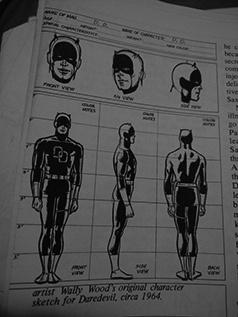
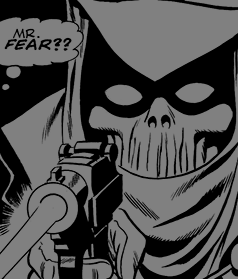
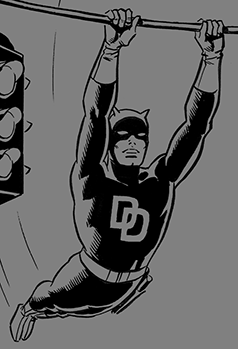
© 2023 Wallace Wood Properties LLC. All Rights Reserved.
All Marvel characters and the distinctive likeness(es) thereof are Trademarks & Copyright © 1941–2023 Marvel Characters, Inc. ALL RIGHTS RESERVED.
Netflix is a registered trademark of Netflix, Inc.
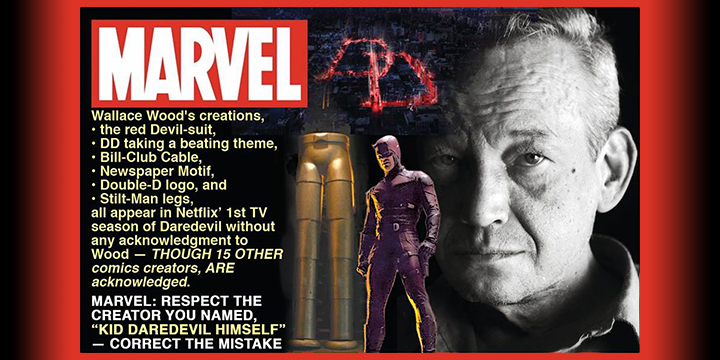
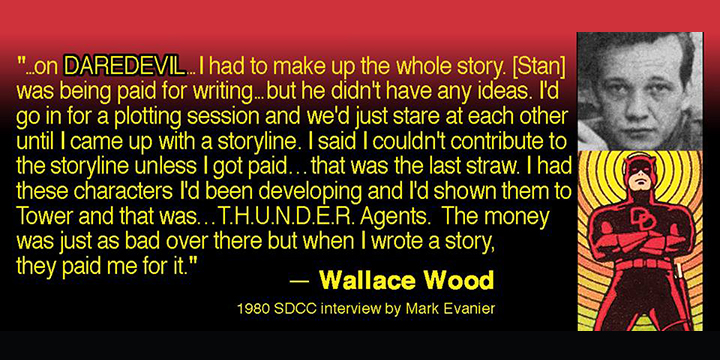

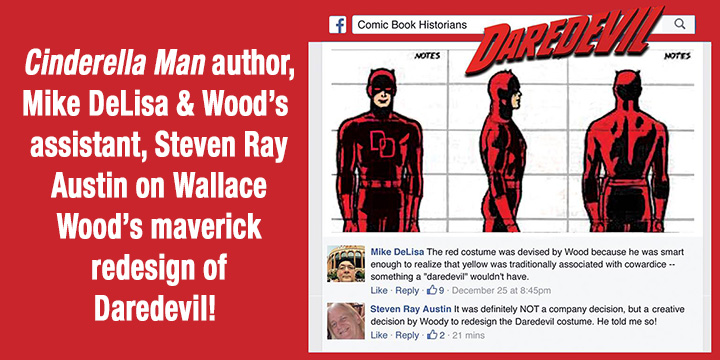
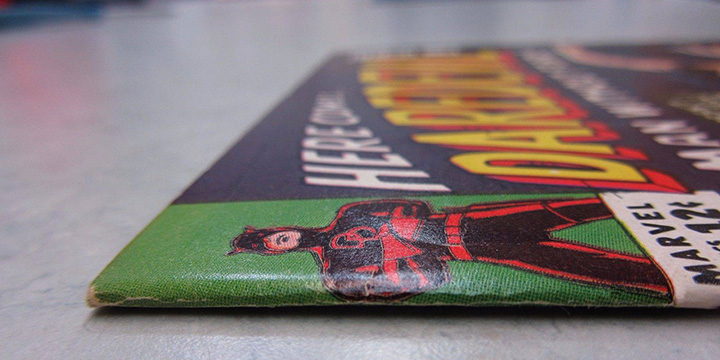
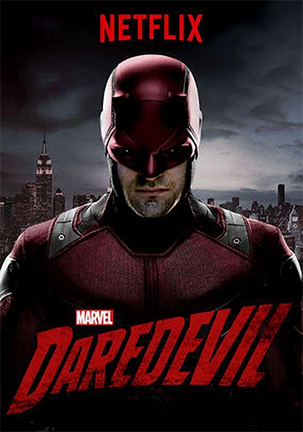

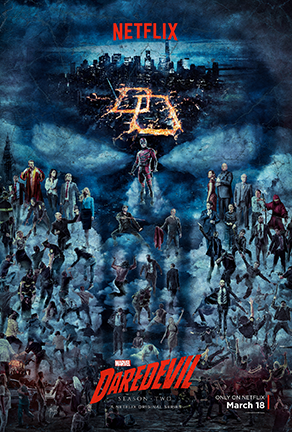
Netfix and Marvel Studios made history with their online hit TV show Daredevil, which was immediately renewed for a second season. But with all the fanfare has come a major controversy among comics fans and top professionals alike. Amazingly, though over a dozen Daredevil-related comics professionals were acknowledged in the series credits, the late, legendary creator who, most in-the-know people say, did as much as Stan Lee and Bill Everett, who first launched Daredevil in 1964, is outrageously slighted. No one is more important to Daredevil than Wallace “Wally” Wood! After leaving his historic 12-year hit run on MAD Magazine, in 1964, Wood took over the then foundering, near-cancellation fledgling Daredevil comic after issue #4. Wood created the RED Daredevil character design, the interlocking double-D logo (which inspired the nickname “DD”), developed the visualization of the Radar Sense, created the grappling-hook cane/Billy-club cable, technological enhancements to DD’s senses, themes used through the Frank Miller run, and beyond. Lee and Everett are acknowledged at the opening of the Netflix-Marvel series and many more comic-book talents are thanked in the Netflix Daredevil show but not “Kid Daredevil Himself, Wally Wood” as Marvel sometimes called him! — To people familiar with Wood’s contributions, the slight is Unacceptable!
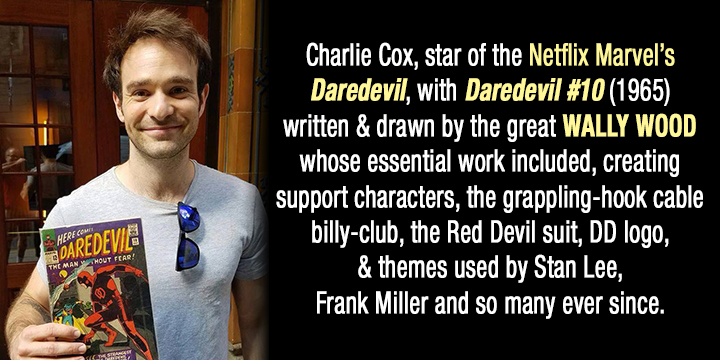




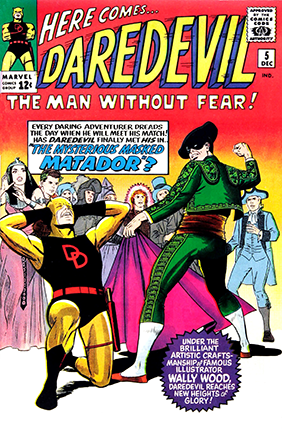
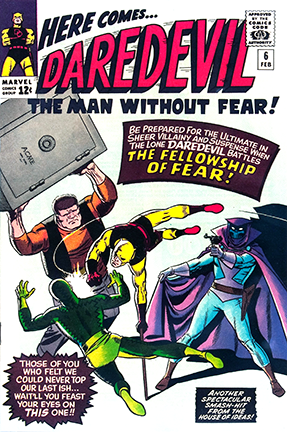
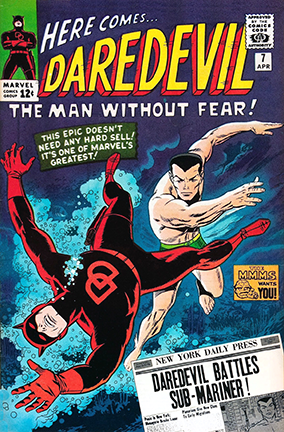
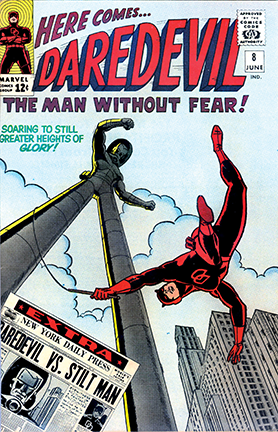
When Wood took over Daredevil, the half-developed character was dressed in a yellow acrobat’s costume. Wood found it ridiculous to dress “the Man Without Fear” in yellow, the color of cowardice and took it upon himself, without Marvel’s request or approval, to change DD’s outfit to the all-red suit he has donned lo, the past 50 years. Wood’s design inspired all red Daredevil designs since, including those in the 2003 Daredevil movie staring Ben Affleck and the new Netflix series alike. Wood plotted his DD stories, often uncredited — which inspired him to leave Marvel after one year — and that character development is inherent in near all Daredevil including Sin City creator, Frank Miller’s famous run. That is why Roy Thomas, Denny O’Neil and other all-time top comics industry pros are speaking out, in favor of Wood being listed at the beginning of each episode with Stan Lee and Bill Everett (not at the end for individual episode contributions).



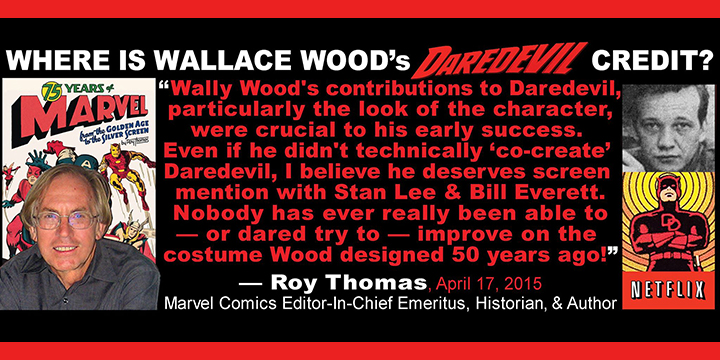
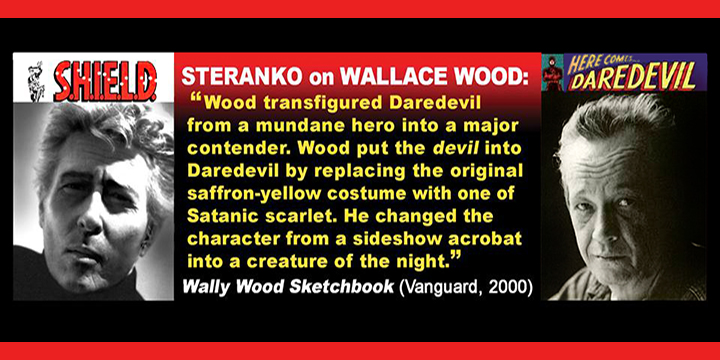
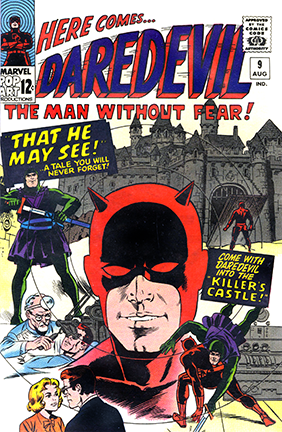
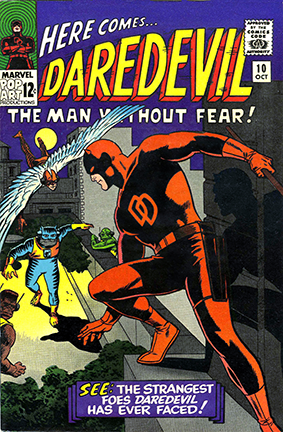
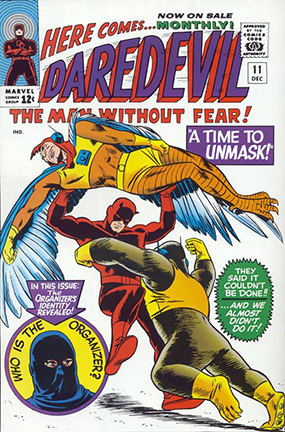
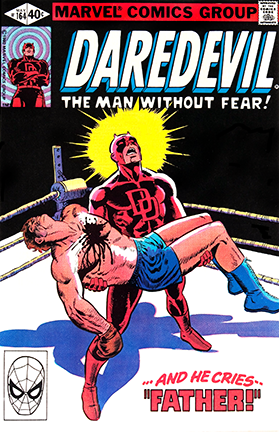
In his one year developing Daredevil, Wood brought sales from a near-cancellation bi-monthly to a hit monthly. The success continued through Romita’s handful of post-Wood issues but soon slipped back to a bi-monthly where it soldiered on for years afterward, only to return again to Wood’s hit monthly level of sales, over a decade later, under Frank Miller. Miller’s famous latter run on Daredevil revived many themes that were originally created by “Kid Daredevil himself,” Wallace Wood. Elsewhere, Miller has paid tribute to Wood in SIN CITY (including in the credits to the SIN CITY movie) and his comic, Tales to Offend, including “Lance Blastoff” which was a total homage to Wood.
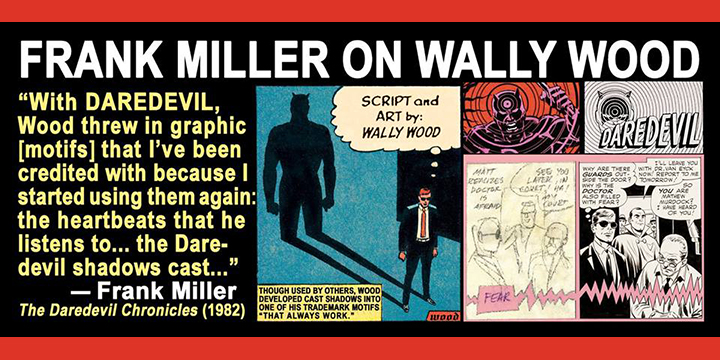
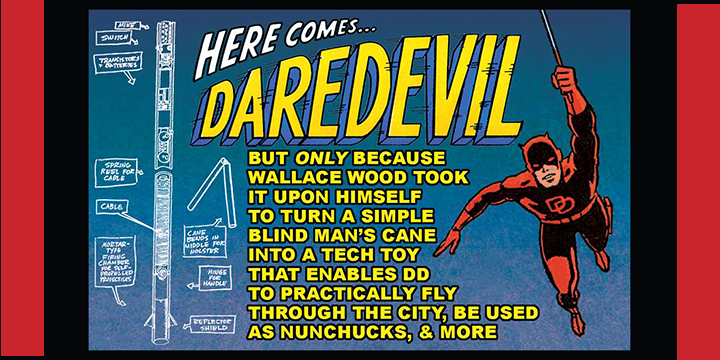
Wood’s Daredevil Contributions:
1) DESIGN MODEL SHEETS: Contemporaneous to Wood’s RED Daredevil redesign, Wood created character turnaround model sheets for: Daredevil, Matt Murdock, Karen Page, Foggy Nelson, and design schematic of Daredevil’s Cane Billy-Club with grappling hook cable.
2) WRITING: While officially credited as fully writing only Daredevil issue #10, Wood plotted all of his Daredevil issues under the “Marvel Method” same as his collogues, Fantastic Four co-creator, Jack Kirby and Spider-Man co-creator, Steve Ditko. VIA HIS PLOTS, WOOD DISTILLED THE ESSENCE OF DAREDEVIL
“Wood’s… Daredevil is defined not by who he defeats so much as by his stubborn refusal to bow down to the most overwhelmingly fearsome of opponents.” said Colin Smith. Wood wrote/plotted/co-wrote Daredevil. Via his story plots, Wood developed Daredevil into the character we all know and love. Most of the very best of the character’s adventures ever since have reflected Wood’s themes, including through Frank Miller’s run to this very day and the Netflix series. The McKenzie-Miller tale from Daredevil #163, effectively re-ran Wood’s classic tale with the Hulk standing in for the Sub-Mariner.
3) NEW CHARACTERS: Wood created various support characters during his Daredevil tenure including Mr. Fear, and Stilt-Man, whose hydraulic legs made a cameo “Easter egg” appearance in the first season of Netflix’s Daredevil. Wood added telescoping legs to his earlier creation idea “The Destroyer” to create Stilt-Man. According to the letters page in DD #8, Stan Lee’s only suggestion was to make the stilts even longer after which Jack Kirby joked about making them even longer.
4) RADAR SENSE: While Daredevil had higher senses from the first issue, Wood developed a very important way to visually communicate DD’s “radar sense” with a series of radiating, expanding circular lines which quickly became a key, trademark representation of the character.
5) INTERLOCKING DD LOGO: Wood changed the single-D on Daredevil’s belly to an interlocking double-D design on Daredevil’s chest. Wood’s design inspired the nickname “DD” and became an internationally recognized trademark which is used everywhere including Marvel’s Netflix series.
6) “KID DAREDEVIL HIMSELF, WALLY WOOD”
Honored that they had acquired MAD’s star talent (with Wood, MAD had been selling 10 times what the best Marvel comic sold), Marvel lauded Wallace Wood with various titles including “Famous Illustrator, Wallace Wood,” “Wondrous Wally Wood,” and for his landmark contributions to DAREDEVIL, he was sometimes referred to as “Kid Daredevil Himself, Wally Wood” including on the 1965 45rpm record “THE VOICES OF MARVEL COMICS” and later, even in the headline to the 1971 Rolling Stone magazine cover article on Marvel.
7) TECHNOLOGY & THE BILLY-CLUB: Also, it was Wood who added all the technology to DD. Stan didn’t like it and deleted it after Wood left, but later talents including Miller, Marvel Studios and Netflix returned to the Wood’s concept of technological enhancements.
8) SALES: In his one year developing Daredevil, Wood brought sales from a near-cancellation bi-monthly to a hit monthly. The success continued through Romita’s handful of post-Wood issues but soon slipped back to a bi-monthly where it soldiered on for years afterward, only to return again to Wood’s hit monthly level of sales, over a decade later, under Frank Miller.
9) CONTINUED INFLUENCE: One indication of Wood’s ongoing influence on Daredevil, long after Wood left over non-payment for his writing, is that, Marvel’s prime representation of the character continued to be Wood’s Daredevil cover corner icon which ran through Romita’s entire DD run and well into Colan’s. In fact, Marvel brought back the Wood icon over a DECADE later (though re-inked by Romita) which ran from 1978 – 1980 including Wood’s historic, last return to Marvel, which was the cover to Daredevil #164 with Frank Miller.
1) DESIGN MODEL SHEETS: Contemporaneous to Wood’s RED Daredevil redesign, Wood created character turnaround model sheets for: Daredevil, Matt Murdock, Karen Page, Foggy Nelson, and design schematic of Daredevil’s Cane Billy-Club with grappling hook cable.
2) WRITING: While officially credited as fully writing only Daredevil issue #10, Wood plotted all of his Daredevil issues under the “Marvel Method” same as his collogues, Fantastic Four co-creator, Jack Kirby and Spider-Man co-creator, Steve Ditko. VIA HIS PLOTS, WOOD DISTILLED THE ESSENCE OF DAREDEVIL
“Wood’s… Daredevil is defined not by who he defeats so much as by his stubborn refusal to bow down to the most overwhelmingly fearsome of opponents.” said Colin Smith. Wood wrote/plotted/co-wrote Daredevil. Via his story plots, Wood developed Daredevil into the character we all know and love. Most of the very best of the character’s adventures ever since have reflected Wood’s themes, including through Frank Miller’s run to this very day and the Netflix series. The McKenzie-Miller tale from Daredevil #163, effectively re-ran Wood’s classic tale with the Hulk standing in for the Sub-Mariner.
3) NEW CHARACTERS: Wood created various support characters during his Daredevil tenure including Mr. Fear, and Stilt-Man, whose hydraulic legs made a cameo “Easter egg” appearance in the first season of Netflix’s Daredevil. Wood added telescoping legs to his earlier creation idea “The Destroyer” to create Stilt-Man. According to the letters page in DD #8, Stan Lee’s only suggestion was to make the stilts even longer after which Jack Kirby joked about making them even longer.
4) RADAR SENSE: While Daredevil had higher senses from the first issue, Wood developed a very important way to visually communicate DD’s “radar sense” with a series of radiating, expanding circular lines which quickly became a key, trademark representation of the character.
5) INTERLOCKING DD LOGO: Wood changed the single-D on Daredevil’s belly to an interlocking double-D design on Daredevil’s chest. Wood’s design inspired the nickname “DD” and became an internationally recognized trademark which is used everywhere including Marvel’s Netflix series.
6) “KID DAREDEVIL HIMSELF, WALLY WOOD”
Honored that they had acquired MAD’s star talent (with Wood, MAD had been selling 10 times what the best Marvel comic sold), Marvel lauded Wallace Wood with various titles including “Famous Illustrator, Wallace Wood,” “Wondrous Wally Wood,” and for his landmark contributions to DAREDEVIL, he was sometimes referred to as “Kid Daredevil Himself, Wally Wood” including on the 1965 45rpm record “THE VOICES OF MARVEL COMICS” and later, even in the headline to the 1971 Rolling Stone magazine cover article on Marvel.
7) TECHNOLOGY & THE BILLY-CLUB: Also, it was Wood who added all the technology to DD. Stan didn’t like it and deleted it after Wood left, but later talents including Miller, Marvel Studios and Netflix returned to the Wood’s concept of technological enhancements.
8) SALES: In his one year developing Daredevil, Wood brought sales from a near-cancellation bi-monthly to a hit monthly. The success continued through Romita’s handful of post-Wood issues but soon slipped back to a bi-monthly where it soldiered on for years afterward, only to return again to Wood’s hit monthly level of sales, over a decade later, under Frank Miller.
9) CONTINUED INFLUENCE: One indication of Wood’s ongoing influence on Daredevil, long after Wood left over non-payment for his writing, is that, Marvel’s prime representation of the character continued to be Wood’s Daredevil cover corner icon which ran through Romita’s entire DD run and well into Colan’s. In fact, Marvel brought back the Wood icon over a DECADE later (though re-inked by Romita) which ran from 1978 – 1980 including Wood’s historic, last return to Marvel, which was the cover to Daredevil #164 with Frank Miller.







